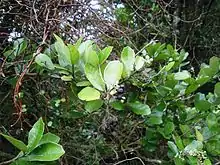Pennantia corymbosa
Pennantia corymbosa, commonly known as kaikomako (from the Māori kaikōmako), is a small dioecious forest tree of New Zealand.
| Pennantia corymbosa | |
|---|---|
 | |
| Scientific classification | |
| Kingdom: | Plantae |
| Clade: | Tracheophytes |
| Clade: | Angiosperms |
| Clade: | Eudicots |
| Clade: | Asterids |
| Order: | Apiales |
| Family: | Pennantiaceae |
| Genus: | Pennantia |
| Species: | P. corymbosa |
| Binomial name | |
| Pennantia corymbosa J.R.Forst. & G.Forst. | |
Small creamy, white flowers are produced between November and February, followed by a shiny black fruit in autumn. They are a favourite food of the New Zealand bellbird.
The Māori name kaikōmako means food (kai) of the bellbird (kōmako). Traditionally, Māori used the tree to make fire by repeatedly rubbing a pointed stick into a groove on a piece of mahoe.[1]
An English name is "duck's foot", coming from the shape of the juvenile plant's leaf.[2] Juvenile plants have small leaves with tangled, divaricating stems, while mature plants have much larger leaves and a normal tree architecture.

A kaikōmako tree
References
- "Traditional Plant Use By Māori". eske-style. Retrieved 25 August 2012.
- "Kaikomako (Pennantia corymbosa)". Taranaki Educational Resource: Research, Analysis and Information Network. Retrieved 23 April 2012.
This article is issued from Wikipedia. The text is licensed under Creative Commons - Attribution - Sharealike. Additional terms may apply for the media files.
